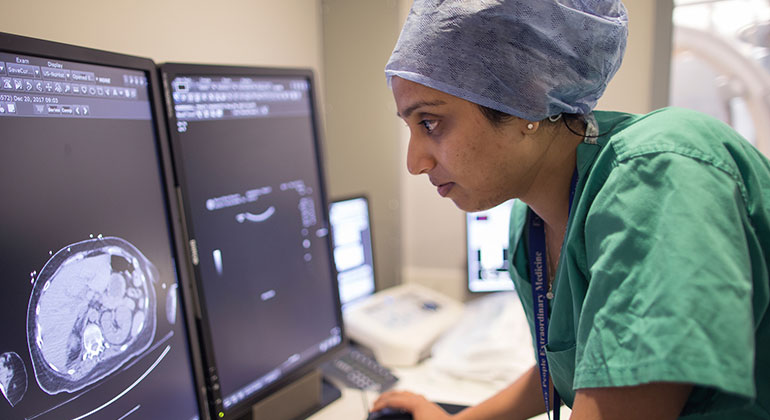Aneurysms

Arteries carry oxygen-rich blood from the heart to the rest of the body. When the wall of an artery becomes weak and develop a bulge, we call it an aneurysm. Aneurysms can cause pain, clammy skin, dizziness, nausea and vomiting, rapid heart rate, shock, and low blood pressure. We worry about aneurysms because they can rupture, or break, and lead to internal bleeding. This can be a life-threatening event.
Mount Sinai Interventional Radiology treats the following conditions:
- Peripheral aneurysms occur in an artery other than the aorta and mostly affect the legs or neck.
- Renal aneurysms affect the artery in the kidney.
- Splenic aneurysms occur in an artery in the spleen.
Treatments We Offer
We design a treatment plan to meet your individual needs. Depending on the condition, we offer specific treatment options. For the conditions that we treat most, the treatment options are:
- Peripheral aneurysms treatment varies based on your health as well as the location and size of the aneurysm. The condition of the surrounding blood vessels may also affect treatment. Our surgeons may prescribe a lifestyle change and regular follow-up for smaller aneurysms. For larger aneurysms, we may suggest an open surgical repair to remove the aneurysm and replace it with a graft. An endovascular repair is a minimal invasive approach.
- Renal aneurysms are bulging weakened areas in the wall of an artery that leads to the kidney. These aneurysms are typically uncommon. Small renal artery aneurysms often may not be treated but monitored for growth. We often treat larger renal aneurysms surgically.
- Splenic aneurysms are the most common of visceral artery aneurysms. They happen more often to women than men. If you have a splenic aneurysm, you may not feel any symptoms. We usually recommend treatment with large asymptomatic splenic aneurysms.
We use various approaches with these treatments. The most common approaches are:
- Embolization: Coil and plug embolization allow are minimally invasive (endovascular) approaches. This means you recover more quickly and have fewer complications than patients who have had open surgery. This technique works best for peripheral, visceral, and renal aneurysms. We insert tiny thread-like material through small tubes, called catheters, into the arteries in your leg or wrist. We direct these catheters to the aneurysm. Then we keep the aneurysm from receiving more blood flow. This approach stops the aneurysm from growing and often makes it shrink and disappear.
- Covered Stent Repair: This approach lets us treat almost any aneurysm in the body without damaging nearby organs. We insert a tube, called a stent, which acts as a new lining for the diseased blood vessel. This allows the vessel to heal. We have found this approach most effective for aortic or iliac aneurysms.
Why Mount Sinai
Our Interventional Radiology team provides high-resolution pictures that help guide minimally invasive procedures. We are one of the top health systems in the country for image-guided procedures. And we put you, our patients, at the heart of everything we do.